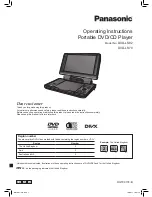
13
Briggs & Stratton Power Products Home Generator System
Owners Manual
This receptacle powers 120/240 Volt AC, 60 Hz, single
phase loads requiring up to 3600 Watts of power at
30 Amps for 120 Volts; 6500 Watts of power (6.5 kW) at
27.1 Amps for 240 Volts.The outlet is protected by a
30 Amp circuit breaker.
CAUTION!
Although this outlet states it has a
240 Volt 30 Amp rating (up to 7,200 Watts), the
generator is only rated for 6,500 Watts. Powering
loads that exceed the wattage/ amperage capacity of
the generator can damage it or cause serious
injuries. 240 Volt loads powered through this outlet
should not exceed 27.1 Amps of current draw.
Light
A light is provided on the control panel to assist movement
in the dark.Turn on the light using the switch on the
control panel.
Always turn off the light when not needed as it drains the
generator battery.Turn off the light when the generator is
running.
How to Use the Battery Charger
Use the battery float charger jack to keep the starting
battery charged and ready for use. Battery charging should
be done in a dry location, such as inside a garage.
• Plug the charger into the unit’s “12V DC Float Charger”
jack, which is located on the control panel (Figure 13).
Plug battery charger into a 120 Volt AC wall receptacle.
• Unplug the charger from the unit and the wall outlet when
generator is being started and while it is in operation.
• Keep this charger plugged in when generator is not in
use to prolong battery life.The charger has a built in float
equalizer and will not overcharge the battery, even when
plugged in for an extended period of time.
IMPORTANT: See “Battery Maintenance” on page 17 for
additional information.
Hour Meter
The hour meter operates whenever the unit’s engine runs.
Use the hour meter to plan service tasks mentioned in the
engine owner’s manuals.
Figure 12 — 120/240 Volt AC, 30 Amp Receptacle
4-Wire Cord Set
240V
120V
120V
W (Neutral)
X (Hot)
Y (Hot)
NEMA L14-30
Ground (Green)
Figure 13 — Battery Charger Jack





































